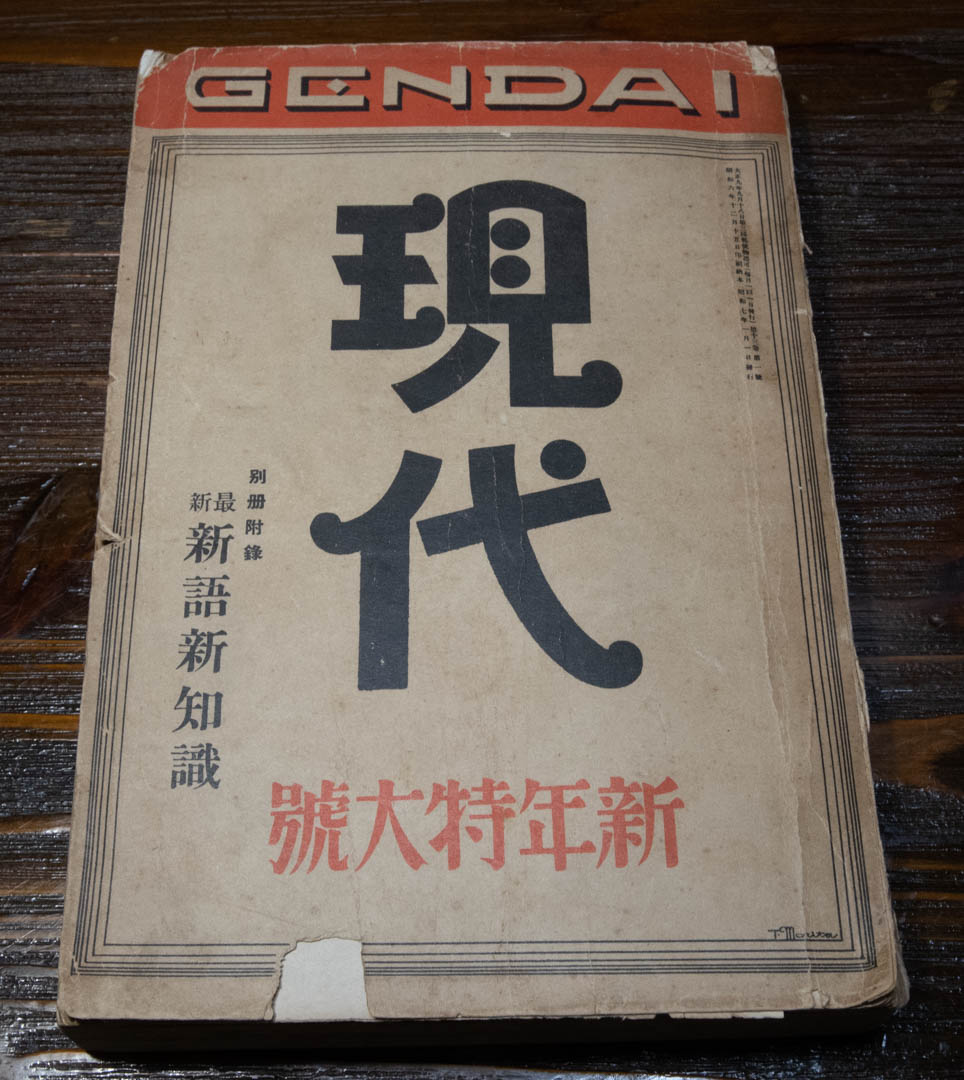
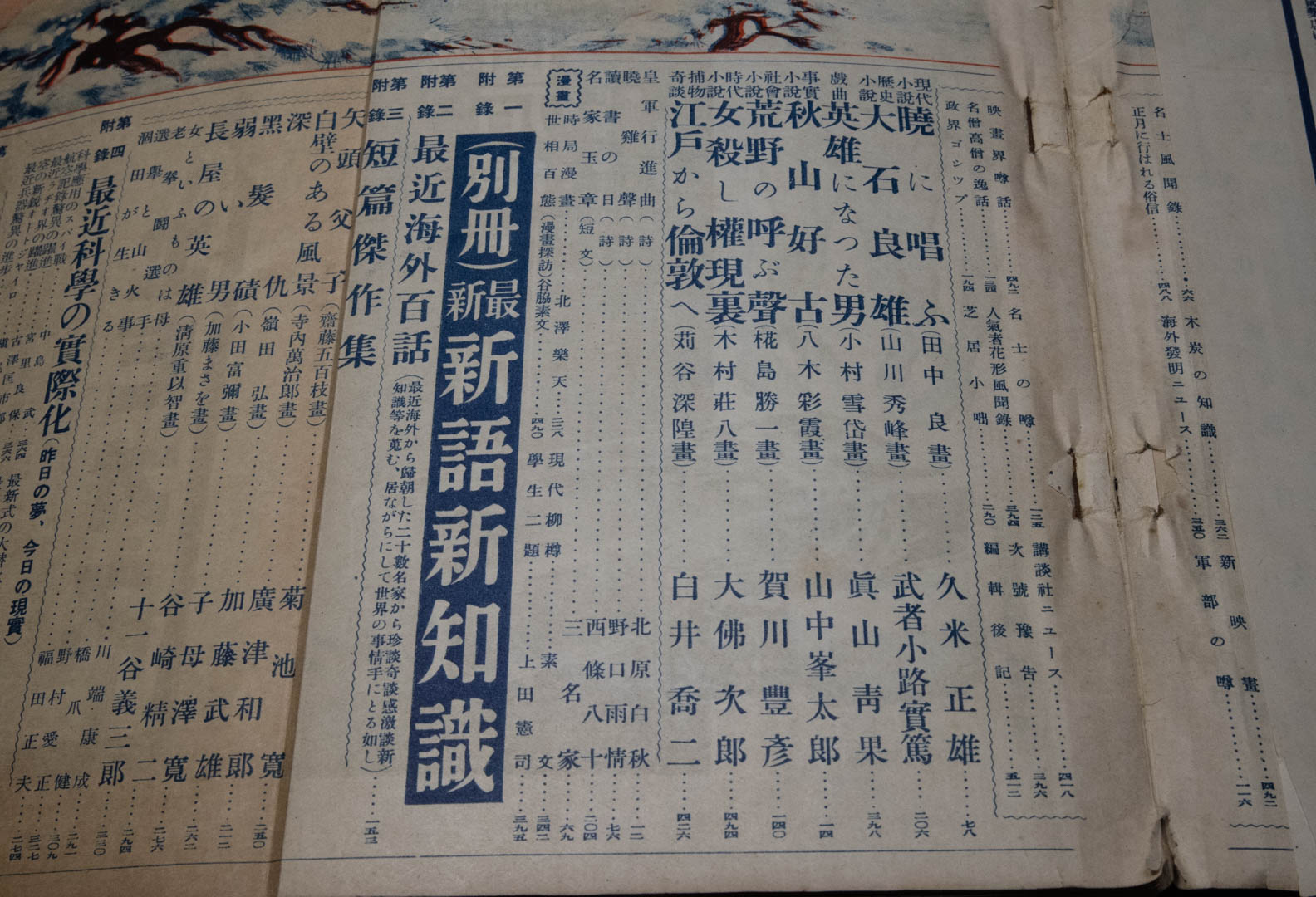 白井喬二の「江戸から倫敦へ」の連載三回分を読了。大日本雄弁会講談社の「現代」の昭和6年(1931年)二月号・三月号と昭和7年(1932年)一月号です。(ちなみに亡父が生まれたのが1932年の1月26日です。)
白井喬二の「江戸から倫敦へ」の連載三回分を読了。大日本雄弁会講談社の「現代」の昭和6年(1931年)二月号・三月号と昭和7年(1932年)一月号です。(ちなみに亡父が生まれたのが1932年の1月26日です。)
読んでみてびっくり、白井喬二の猶太禍捕物帳の第二弾です!
第一弾というのは、「傀儡大難脈」で、何故かユダヤ人が日本の色々な伝統芸能の家の秘伝書を盗んでいくのを、名与力の千面小三郎が暴いていくという話でした。この話を収めた「至仏峠夜話」という本の後書きで、白井自身が「猶太禍捕物帳」を更に書いていく予定があるようなことを述べていました。しかし私はそれで終わったのだと思っていたら、恐るべし、白井喬二、ちゃんと書いていました!
しかも、ユダヤ人が伝統芸能の家の秘伝書を盗んでいくという設定はそのままこの「江戸から倫敦へ」でも使われています。それどころか更に陰謀はこれを入れて全部で10あり、他は日本語を乱れさせる、教育を頽廃させる、機械により人間の職を奪う、風紀を紊乱する、女性の良い所を無くす、武術を貶めて文弱にする、国土をならす、重職にある武士の暗殺、という実に恐るべきものです。しかしいくらなんでも、江戸時代の日本に対して何故ユダヤ人がそんな陰謀を企むのかその辺りはまったく書いていないように思います。
ともかく一話読んだだけでも、荒唐無稽の極地で、ユダヤ人差別はいただけませんが、ストーリーとしては実にわくわくさせる展開でした。この頃の「現代」は日本の古本屋さんサイトで後2冊見つけて取り寄せ中ですが、全部(18回)読んでみたいものです。
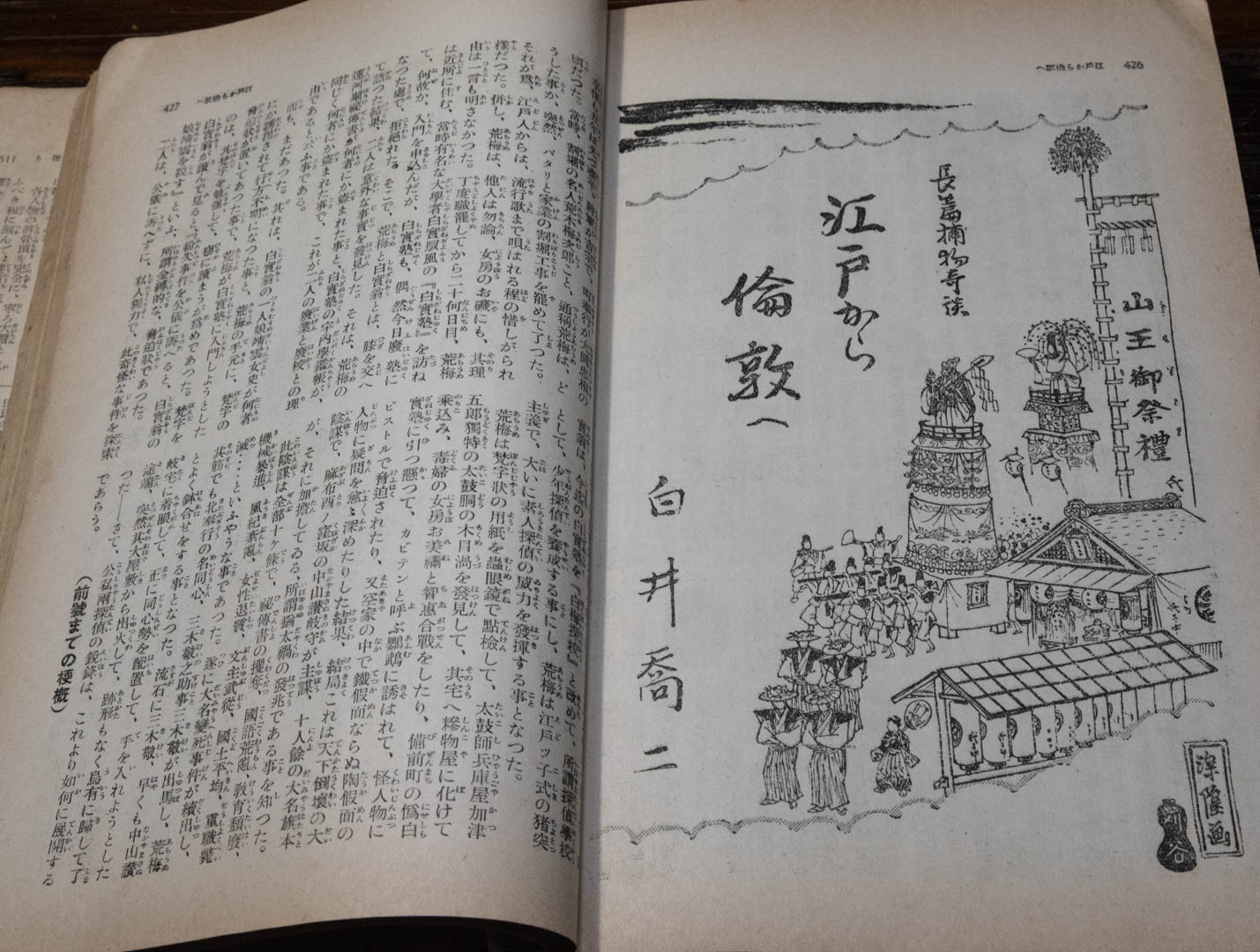
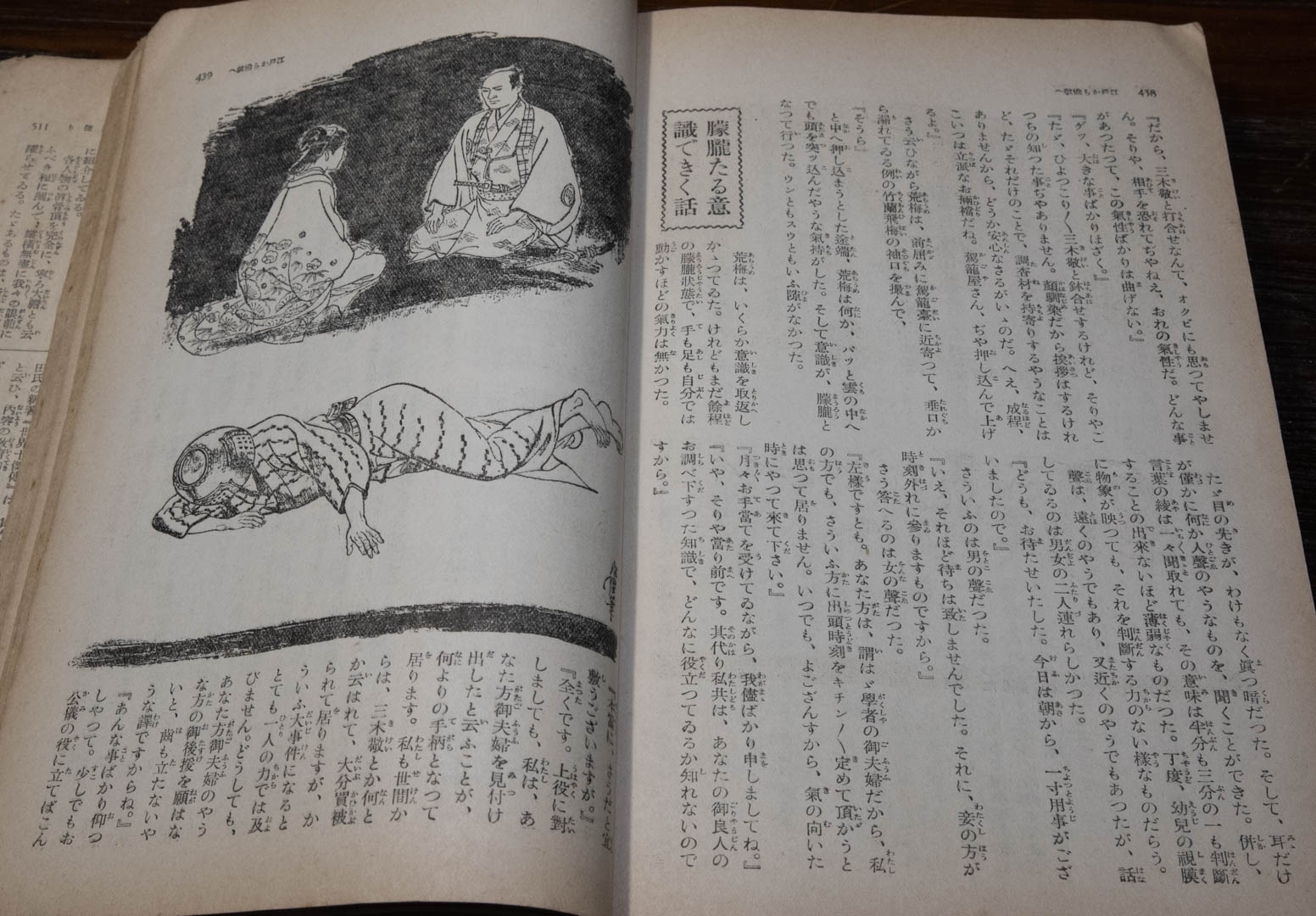
投稿者: kanrisha
宇宙家族ロビンソンの”One of Our Dogs Is Missing”
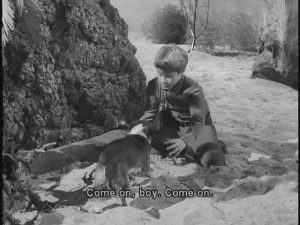 宇宙家族ロビンソンの”One of Our Dogs Is Missing”を観ました。出ました!恐怖のWilliam Welch脚本です。なのでとことんナンセンスな事件が続きます。まずは何故かロビンソン一家のいる星で地球の子犬が見つかります。初期の宇宙実験に使われたのが生き延びたという設定ですが、南極物語かよ!タローとジローは生きていました、みたいな設定です。(ソ連が人工衛星にライカ犬を乗せて打ち上げたのは有名ですが、そのライカ犬は打ち上げ直後に部屋の中が高熱になりすぐ死んでしまったとされています。)それよりさらに意味不明なのは、ナマハゲか日本の鬼みたいなエイリアンで、結局何がしたかったのかがさっぱり不明で、レーザーで数回撃たれても平気で生きていて、結局隕石が作ったクレーターの砂の中に消えて行きます。ドクター・スミスのナンセンス振りもWelch脚本だと拍車がかかり、何故かジュピター2号のレーザーガン全てを分解して元に戻せなくなってしまいます。また、子犬をエイリアンのスパイだと言い張り、子犬を探して撃ち殺す捜索隊を結成したりします。モーリーンはそういう状況に自分ではどうにも出来なくて、ロビンソン博士に無線で連絡しますが、博士が重要なミッション中ということで自分達の危険を言い出せず、でもロビンソン博士がモーリンの声の調子がおかしいのに気がついてすぐに引き返すという、1960年代らしい男女の役割のステレオタイプな描写が見られます。
宇宙家族ロビンソンの”One of Our Dogs Is Missing”を観ました。出ました!恐怖のWilliam Welch脚本です。なのでとことんナンセンスな事件が続きます。まずは何故かロビンソン一家のいる星で地球の子犬が見つかります。初期の宇宙実験に使われたのが生き延びたという設定ですが、南極物語かよ!タローとジローは生きていました、みたいな設定です。(ソ連が人工衛星にライカ犬を乗せて打ち上げたのは有名ですが、そのライカ犬は打ち上げ直後に部屋の中が高熱になりすぐ死んでしまったとされています。)それよりさらに意味不明なのは、ナマハゲか日本の鬼みたいなエイリアンで、結局何がしたかったのかがさっぱり不明で、レーザーで数回撃たれても平気で生きていて、結局隕石が作ったクレーターの砂の中に消えて行きます。ドクター・スミスのナンセンス振りもWelch脚本だと拍車がかかり、何故かジュピター2号のレーザーガン全てを分解して元に戻せなくなってしまいます。また、子犬をエイリアンのスパイだと言い張り、子犬を探して撃ち殺す捜索隊を結成したりします。モーリーンはそういう状況に自分ではどうにも出来なくて、ロビンソン博士に無線で連絡しますが、博士が重要なミッション中ということで自分達の危険を言い出せず、でもロビンソン博士がモーリンの声の調子がおかしいのに気がついてすぐに引き返すという、1960年代らしい男女の役割のステレオタイプな描写が見られます。
ベトナム語の入門書入手
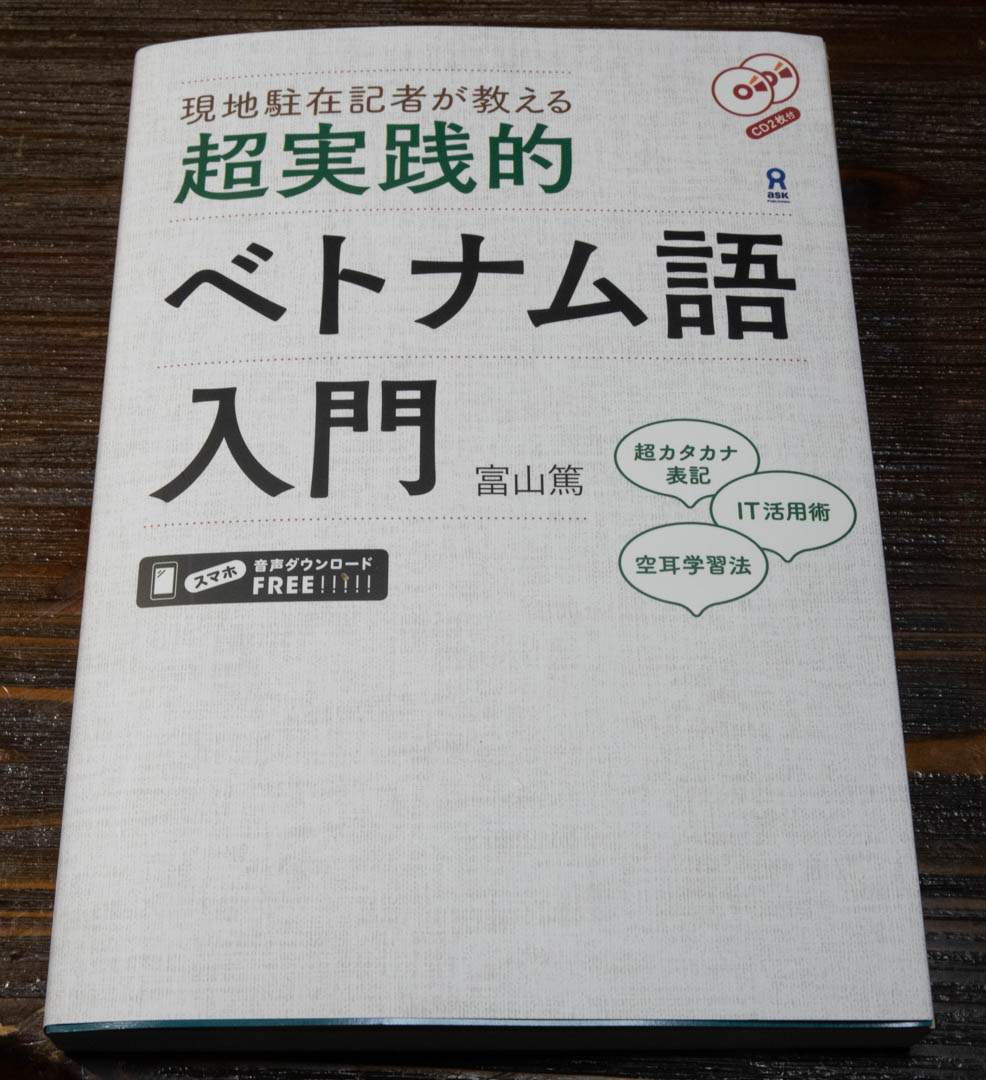 技能実習生について調べていて、一番被害に遭っているのはベトナム人でした。ベトナムは国を挙げて労働者の「輸出」を推進していて、その過程での中間業者への規制が機能していないこと、そして社会主義の国なのに労働者の地位が低く、基本的な労働者の権利といった教育を国民に対してほとんどしていない、またフィリピンなどがもっと昔から労働者送り出しの経験を持っていて、それなりに国の支援機構があるのに対し、ベトナムがドイモイ後国を開いてから歴史が浅く、労働者の海外送り出しについて国の支援がほとんどありません。
技能実習生について調べていて、一番被害に遭っているのはベトナム人でした。ベトナムは国を挙げて労働者の「輸出」を推進していて、その過程での中間業者への規制が機能していないこと、そして社会主義の国なのに労働者の地位が低く、基本的な労働者の権利といった教育を国民に対してほとんどしていない、またフィリピンなどがもっと昔から労働者送り出しの経験を持っていて、それなりに国の支援機構があるのに対し、ベトナムがドイモイ後国を開いてから歴史が浅く、労働者の海外送り出しについて国の支援がほとんどありません。
そういう訳で、何かの役に立つかもしれないと思って、これをポチってみました。これまで手を出したアジアの言語は、かなり勉強した韓国語を除くと、広東語少し、マレー語(インドネシア語)少し、タイ語ほんの少し(以前在籍したソフトウェア会社でIPAのプロジェクトで、多言語対応インプットメソッドというので応募し、対応言語が日本語・中国語・タイ語だったので、ちょっとだけ文字を中心に勉強したもの)ぐらいです。
ベトナム語は基本的に独立語(膠着語や屈折語ではないという意味での)ですが、中国語の影響を強く受けていて、中国語は4声ですが、ベトナム語は6声あるようで、なかなか敷居は高そうです。ただ文字はアクセント記号付きアルファベットなのでそこは入りやすいです。
巣内尚子の「奴隷労働 ベトナム技能実習生の実態」
 巣内尚子の「奴隷労働 ベトナム技能実習生の実態」を読了。著者は社会学修士でフランス→インドネシア→フィリピン→ベトナム→日本と移り住んだ経験を持つフリージャーナリストです。元はYahoo! ニュースに2016年から寄稿したものがベースになっています。ともかく実際のベトナム人技能実習生の話が多数紹介されていてとても参考になります。技能実習生の搾取で、縫製業者が多いのは、要するに中国の安い縫製業者に価格的に対抗出来ない、ほとんどつぶれかけている日本の縫製業者(多いのは岐阜県、徳島県、佐賀県)が技能実習生の以前から最低賃金違反、残業代未払いなどを続けていて日本人従業員が雇えないような状況になっていて、そこで技能実習生を使っているということです。一方の技能実習生側では特に手に職がなく建設業のような肉体の力を要求する仕事も出来ない女性の場合、縫製業者ぐらいしか働く所がないという事情があります。しかし男性の側でも、建設会社に雇われたとしても、この本の中に福島県で、それと教えてもらわないで実は除染作業をやらされていたというひどい例が出てきます。他にも、最低賃金違反、残業代未払い、給料未払い、休日が月1回も無い場合がある、セクハラ、パワハラ、相場と内容から見て不当に高い家賃の天引き、パスポート取り上げ、外出禁止、誰が見ても奴隷制度そのもの、人身売買です。しかもそうした待遇に耐えられなくて、逃げ出した場合からは入国管理局から不法就労者として追われ、見つかれば強制帰国となります。そうなると祖国を離れる時に負った100万円(日本人の感覚なら1000万円)を超える借金を返すことが出来なくなり、担保に入れた農地が取り上げられてしまいます。
巣内尚子の「奴隷労働 ベトナム技能実習生の実態」を読了。著者は社会学修士でフランス→インドネシア→フィリピン→ベトナム→日本と移り住んだ経験を持つフリージャーナリストです。元はYahoo! ニュースに2016年から寄稿したものがベースになっています。ともかく実際のベトナム人技能実習生の話が多数紹介されていてとても参考になります。技能実習生の搾取で、縫製業者が多いのは、要するに中国の安い縫製業者に価格的に対抗出来ない、ほとんどつぶれかけている日本の縫製業者(多いのは岐阜県、徳島県、佐賀県)が技能実習生の以前から最低賃金違反、残業代未払いなどを続けていて日本人従業員が雇えないような状況になっていて、そこで技能実習生を使っているということです。一方の技能実習生側では特に手に職がなく建設業のような肉体の力を要求する仕事も出来ない女性の場合、縫製業者ぐらいしか働く所がないという事情があります。しかし男性の側でも、建設会社に雇われたとしても、この本の中に福島県で、それと教えてもらわないで実は除染作業をやらされていたというひどい例が出てきます。他にも、最低賃金違反、残業代未払い、給料未払い、休日が月1回も無い場合がある、セクハラ、パワハラ、相場と内容から見て不当に高い家賃の天引き、パスポート取り上げ、外出禁止、誰が見ても奴隷制度そのもの、人身売買です。しかもそうした待遇に耐えられなくて、逃げ出した場合からは入国管理局から不法就労者として追われ、見つかれば強制帰国となります。そうなると祖国を離れる時に負った100万円(日本人の感覚なら1000万円)を超える借金を返すことが出来なくなり、担保に入れた農地が取り上げられてしまいます。
またひどいのが監理団体で、技能実習生から相談があっても何もしないどころか、ひどいケースでは技能実習生の雇用主が監理団体を兼ねていたりする場合もあります。またほとんどの監理団体が農協や漁協、同業者組合の類いで、技能実習制度のために出来た団体では元々ありません。
救いは、少しずつではありますが、日本国内で技能実習生を支援しようとする人が増えていること。しかし、本当の意味での問題の解決は技能実習制度そのものを無くすことです。
BBCのニュース「搾取された移民労働者」
BBCが8月25日に、動画ニュースにて、日本の技能労働者の搾取の問題を取り上げました。
現在、BBCのサイトだけでなく、YouTubeにも上がっています。
そのニュースの日本語訳を作りました。一人でも多くの方にこの問題を知っていただきたいので、BBCの許可をもらっていませんが、ここで公開します。(BBCから取り下げて欲しいという依頼があれば取り下げますので、予告なく削除する場合があります。)
BBCニュース 2019年8月25日
Migrant workers ‘exploited’ in Japan
日本で「搾取」される移住労働者達
https://www.bbc.com/news/av/world-asia-49448757/migrant-workers-exploited-in-japan
https://www.youtube.com/watch?v=wPcaIL8PFJ4
これはよく知られた話です。
発展途上国から来た人々が、飽くことを知らないグローバル市場に向けた商品を量産しています。
でももしもそうした商品が日本で作られているとしたらどうでしょう?
そして政府の移民の枠組みにのっとった搾取が行われているという申し立てが露見したとしたら。
「6ヵ月の間、一日の休みもありませんでした。」
「工場の人達は、私が一人だけ工場に残っている時に、一人で機械を動かすように依頼しました。」
「私は本当にその機械の動かし方を知りませんでした。」
「私はもうここに住みたくありませんでした。」
「そして自分自身の暮らしを取り戻そうとしました。」
彼らは本当は実習生の筈でした。
日本に来て、お金を稼ぎ、技能を学ぶための。
でも実際は、彼らは「搾取された」と申し立てています。
日本政府の枠組みにのっとり、何千ものビジネスがその枠組みの中にあります。
その中には日本のもっとも良く知られたブランドもあります。
日本は移民が必要だと言っています。
でも本当にそうなのでしょうか?
こうした移民労働者が最後に行き着くのは、この町のような工場街です。
何故なら、そうした場所では日本の企業が必死になって作業員を求めているからです。
この地区に移住労働者のための救護施設があります。
その施設はベトナム、中国、カンボジアからの移住者を受入れてきています。
そして彼らがその雇用主との間で抱える訴訟事例について支援しています。
「最初にここに着いた後は、朝の6時半から深夜まで働きました。」
「6ヵ月の間、一日の休みもありませんでした。」
チャンさんは日本にお金を稼ぐために来ました。
息子さんに立派な結婚式を挙げさせてやるためです。
チャンさんは衣服を作る小さな会社で働きました。
そこで搾取されたと言っています。
「給与明細書はすべてデタラメです。」
チャンさんは私に一年間記録し続けたメモを見せてくれました。
それは実際の労働時間を記録したものでした。
チャンさんは残業代がまったく支払われなかったと言っています。
そして未払いの賃金が5万ドル(525万円)になると言っています。
「仕事は本当に疲れ果てるもので、足が腫れ上がり腰を痛めました。」
「いつも頭痛が続き、夜中に泣きたくなりそうでした。」
「でもそれを上長に言うのが恐かったのです。」
「何故なら私の体調が良くないのを上長が知ったら私を首にするだろうと思ったからです。」
我々は他の2人にも話を聞きました。どちらも中国から来ています。
その2人もこの会社の労働慣行について同様のことを申し立てました。
この会社はそうした申し立てを否定しました。
それによるとすべての従業員には最低賃金を支払っていると言っています。
また労働時間についてのものも含めて雇用に関する全ての法律を遵守していると言っています。
(画面のみ)
「当社の基本給は最低賃金に基づいて計算されています。
…
また残業代も支払っています。」
そして彼らが発行している給与明細は正確だと主張しています。
また従業員が会社の建物を出るのは自由だとも言いました。
そして一日の就業時間が始まった後でもスーパーマーケットに行くのも許可されていたと言いました。
「これがあなたが服に縫い付けていたタグですか?」
「この服はコムデギャルソンの製品です。こんなのを沢山見ましたか?」
「こういうタグが沢山あったと思います。」
「こちらはバーニーズ・ニューヨークで売っている製品です。」
私達はこうした申し立てをバーニーズ・ニューヨークとコムデギャルソンに伝えました。
どちらの会社もこの工場とは直接の取引は無いと言います。
そしてこの工場が使われているのは、彼らのサプライチェーンでのコントロールすることが出来ないアウトソーシング(外注)の結果だとしています。
(画面のみ)
コムデギャルソンは従業員の労働条件、健康と安全について厳格な条件を定めています。
コムデギャルソンは彼らは一緒に仕事をしている全ての工場の従業員の労働条件、健康と安全について、厳格な条件を定めていると強く主張しています。
この人(チャンさん)はコムデギャルソンがその存在を知らないし外注の同意もしていない下請け企業に雇われたのだと言います。
下請け企業はきちんとした手続きを取っており、こうしたことが2度と起きないことを保証しています、とコムデギャルソンは言っています。
バーニーズ・ニューヨークは、この会社に対し何も直接注文したことはないし、現在本件について調査中であると述べています。
日本には技能実習生を雇っている会社が6000あります。
2017年の報告では、日本政府はその内の70%の会社が違法残業や残業代未払いなどの規制違反を行っていたとしています。
それでは何故政府の枠組みがそのような制度の悪用という泥沼に陥ったのでしょうか?
過去何世紀にも渡って、日本は外国から自らを隔離し閉じこもってきました。
その結果日本は世界の中でもっとも均質性の高い社会となりました。
今その社会は(老齢化と人口減少という)人口動態的な時限爆弾を抱えています。
日本は今必死になって働き手を求めています。
そして技能実習制度は多くの会社にとって、安価な外国からの労働者を雇うための手段になっています。
しかし実習生の多くは日本語を話せません。
そして自分が持つ様々な労働者としての権利についてきちんと説明されている人はほとんどいません。
その結果制度の悪用の被害に遭いやすくなってしまっています。
そしてBBCはこの会社以外で働いていて、悲惨な経験をしている技能実習生にも話を聞きました。
「最初にここに来た時は、事前に想像していた通り、とてもいい所だと思いました。」
「ここは本当に清潔です。まったく。」
中国でフアンさんは日本語を勉強しました。
日本に来て日本語がもっと流暢になることを期待しており、箱(段ボール箱?)を製造している工場に職を得ました。
「私が下に付いた上長は私が「こんにちは」と挨拶しても何も返事をしませんでした。」
「仕事の指導もほとんどしてくれませんでした。」
「私は工場の機械に手を挟まれてしまいました。」
「工場のオーナーは私を中国に送り返そうとしました。」
フアンさんは(労災として)補償を得ようとしましたが、工場のオーナーは自分は破産を宣告したといって取り合いません。
そしてもしその訴えが認められた場合には、フアンさんの雇用とその労災事故自体が無かったことにされるのです。
「私達はトマトとキュウリを育てています。」
チェン・カイさんはフアンさんとチャンさんが滞在している救護施設を運営しています。
二人は救護施設ではあまりする事がないのです。
農作業は二人が他のメンバーと話をしたり付き合ったりするのの手助けになります。
「今それを動かしたらいけません。駄目になってしまいます。」
「これは上海白菜ですか?」
(画面)
シーさん、中国人技能実習生
「今ここでは他の人と冗談を言ったり笑ったりすることが出来ます。」
「でもすぐ次の瞬間後ろを向いて泣き出してしまいます。」
「私は以前はこんな人間ではありませんでした。」
「これは心療内科のお医者さんからもらった薬です。」
シーさんは職場でひどいイジメを受けました。
シーさんは外国人であるということだけでイジメの対象にされてしまったように感じました。
「私はその職場でただ一人の女性でした。」
「他の従業員はしばしば下品な冗談を言い合っていました。」
「私は冗談でボスのことを『馬鹿』と言いました。」
「グループリダーがその場にいて、彼は私に怒鳴り立てました。」
「そのグループリーダーはこう言いました。『お前は中国から来た日本での実習生なんだぞ。俺たちがお前の事を罵っている時はただ黙って聞いていればいいんだ。余計な返事をするな。』」
「昼食休憩の間中、私はただ空を見つめていました。」
「ここで暮らすと心底疲れ切ってしまう、と思いました。」
「もう生きていたくありませんでした。」
シーさんは3ヵ月病院に入院し、腰を痛めてしまいました。
もう働くことが出来ないかもしれません。
彼女は今、今回の事件を労災として認めてもらうよう戦っています。
「もし日本に来ていなかったらこんなことは起きていませんでした。」
「あの人達があんなにひどく私をいじめたりしなかったら、私は自殺を試みるようなことはしなかったでしょう。」
日本の法務省はその報告書の中で、5年間で技能実習生157人が死亡しており、その内17人が自殺によるものであるとしています。
技能実習生の支援活動をしている人は、実際の数字はもっと多いとしています。
これらの技能実習生は日本に来て世界を見てやろう、そして学んで将来のために蓄えを作ろうと夢見ていました。
しかしながら実際は彼らは安い労働力として使われただけでした。
今年日本は技能の低い移住者に対しその歴史の中で一度もなかったレベルにまで更に門戸を拡げるとしています。
そして今後5年間で34万5千人を受入れるとしています。
しかしそれらの人がやって来た時、日本は既に日本にいる技能実習生をどう取り扱うのかを考慮する必要があります。
文化人類学受講の思い出/阿部年晴先生
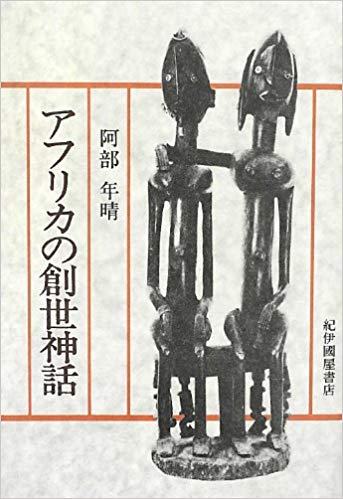 大学の時に文化人類学でアフリカについて、確か「阿部…」という先生の授業を聴講したのを記憶していて、ググって確かめてみたら阿部年晴先生でした。しかし、下記のブログによると2016年に鬼籍に入られているようです。
大学の時に文化人類学でアフリカについて、確か「阿部…」という先生の授業を聴講したのを記憶していて、ググって確かめてみたら阿部年晴先生でした。しかし、下記のブログによると2016年に鬼籍に入られているようです。
ブログ:「王様の耳そうじ」
何で阿部先生のことを思い出したかというと、1980年代にはアフリカに関する本が結構出ていて、私もナイジェリアの民話みたいな本を読んだ記憶がありますし、阿部先生の授業の課題でナイジェリアの複雑な民族構成に関する英語の論文を読んだこともあります。(ハウサとかヨルーバとか、ナイジェリアには全部で数十の部族がいて、お互いに争っていたりします。)先日Eigoxの新しい先生でナイジェリア出身の人がいたので、レッスンを受けようとしてその準備で色々調べてみました。しかし当時の本はことごとく絶版で、かといって新しい本もあまり出ていないようです。(その先生は、結局レッスン直前にキャンセルしてきて、キャンセル率を見たら何と30%もあって、ちょっと問題なんで改めてレッスンを予約することはしていません。)
1980年代は1985年頃から円高が進み、その結果として日本企業の海外進出も進みました。そういう意味で海外に関心があったり仕事で関わる人は多かったのだと思います。文化人類学に関心を持つ人もそれなりにいたと思います。それが今は日本人全体が内向きで閉鎖的になり、あからさまな外国嫌いを標榜する人も増えています。また世界の文化人類学全体でも、サイードのオリエンタリズムによる西洋の植民地主義の正当化という批判を受け、その研究のスタンスが根底から問い直されてきていて、かつてのエネルギーを失っているようです。
私はあくまでもこうした方向とは逆を目指していきたいです。取り敢えず、阿部先生の「アフリカの創世神話」をAmazonでポチりました。
マックス・ヴェーバーの「中世合名会社史」のドイツ語版読書開始
 今日から、マックス・ヴェーバーの「中世合名会社史」のいよいよドイツ語版の読解開始。このヴェーバーの博士号論文は実質的にヴェーバーの学者としてのスタートの論文ですが、これまで何故か日本語に訳されていません。それを無謀かもしれませんが、私が英訳の力を借りて日本語訳しようとしているものです。ドイツ語をまとめて読むのはかなりブランクがあるので心配でしたが、やってみたら意外とスラスラと頭に入ります。この点、ドイツ語は英語より優れていて、英語で本当の意味の読解力をマスターしたのは最近ですが、ドイツ語は大学時代に4年やったくらいでも結構読むことが出来ます。冠詞の格変化があったりするのは覚える時は大変かもしれませんが、一旦マスターすれば文章の意味を理解するには非常に助けになります。後はラテン語とかギリシア語をやったのもプラスになっています。例えばドイツ語で前置詞 in の後に3格(与格)が来ると、「~の場所で(静止)」を意味し、4格(対格)が来ると「~の場所へ(移動)」を意味しますが、こういう前置詞の後ろに来る名詞の格によって意味が違うというのはそのまんまギリシア語にあります。むしろギリシア語の影響でドイツ語に入ったんだと思います。
今日から、マックス・ヴェーバーの「中世合名会社史」のいよいよドイツ語版の読解開始。このヴェーバーの博士号論文は実質的にヴェーバーの学者としてのスタートの論文ですが、これまで何故か日本語に訳されていません。それを無謀かもしれませんが、私が英訳の力を借りて日本語訳しようとしているものです。ドイツ語をまとめて読むのはかなりブランクがあるので心配でしたが、やってみたら意外とスラスラと頭に入ります。この点、ドイツ語は英語より優れていて、英語で本当の意味の読解力をマスターしたのは最近ですが、ドイツ語は大学時代に4年やったくらいでも結構読むことが出来ます。冠詞の格変化があったりするのは覚える時は大変かもしれませんが、一旦マスターすれば文章の意味を理解するには非常に助けになります。後はラテン語とかギリシア語をやったのもプラスになっています。例えばドイツ語で前置詞 in の後に3格(与格)が来ると、「~の場所で(静止)」を意味し、4格(対格)が来ると「~の場所へ(移動)」を意味しますが、こういう前置詞の後ろに来る名詞の格によって意味が違うというのはそのまんまギリシア語にあります。むしろギリシア語の影響でドイツ語に入ったんだと思います。
Wikipedia自警団というハラスメント集団
今回のWikipedia自警団との議論は私の個人の「会話」という場所で行われました。
そもそも「革砥」のページに、「ノート」というのがあり、記事に関する議論は本来はそこですべきです。
それを「会話」でやっているのは、要するになるべく目立たないように気に入らない投稿者を黙らせたいということなのでしょう。またフェアではないのは、こちらは常に一人で、同じような検閲ハラスメントに遭っている人と連帯して議論するのが不可能なのに対し、自警団側は3人も4人も知らない人間が次々出てきます。(なるほど「自警『団』」です。)
しかもその中に含まれる自称「管理者」(真偽不明)が今回、私の「原子力潜水艦シービュー号」の記事の大量削除を行ったのは、この「会話」のページを見ている人間だと認めました。その「管理者」は「愉快犯」という表現を使っていましたが、どこの無関係の暇人がわざわざ私の会話ページに来て、そこでの議論を見て嫌がらせをするのでしょうか。明らかに自警団の内の一人の犯行と確信しています。
この問題は何かの機会にレポートとしてまとめ、Wikipediaの中で如何に陰湿なハラスメントやイジメが横行しているかの証拠として使う予定です。そのためログは全て記録しています。
Wikipediaからオサラバしました。
Wikipedia自警団との戦いについては、その後また今度は管理者と名乗る方(未確認、2度目の書き込みですがその前に書き込んだときはそう名乗っていなかった)からご意見をいただきました。その内容を見て処置無し、と判断し、Wikipediaに対しては今後情報提供を一切止めることを決意しました。以下が最後の書き込みです。
======================================================================
Wikipediaの現行のルールが馬鹿げたものであると考えている人は、私の他にも非常に多く存在しています。この機会に色々調べました。
私はWikipediaの出典形式主義が、記事の信頼性の担保にはほとんど貢献していないと主張しており、別の方法で信頼性の確保に努めています。 Wikipedia自警団と呼ばれている人が、多くはほとんど記事を書いたことがない人達であることに大きな危惧を感じます。 そもそもどんなルールであっても、現実の様々なケースと照らし合わせていくと、単純な適用は不可能であって、どのように適用すべきかという慎重な議論(いわゆる決疑論)が必要と思います。 それを考える上では具体的に自分で記事を書いてみるのが一番と思います。しかるに現在のWikipediaでは記事執筆経験の無い人が管理者を僭称し、他人の記事に「要出典」「独自研究」タグを張りまくっています。 私はこのようなWikipedia日本語版の現状に対してはあくまでも異論を唱えますし、それを理由にして編集ブロックを受けるのであれば、これ以上Wikipediaに情報を提供することは止めます。 しかも、今日は今年6月に書いた記事約69,000バイトを何の連絡もコメントもなくIPアドレス利用者によって全部削除されるという暴挙を経験しました。このようなことはWikipedia利用の15年の中で始めてであり、現在Wikipedia自警団の方々と議論していることとの関連を疑わずにはいられません。 このような陰湿な嫌がらせがまかり通るような閉鎖空間に、これ以上関わる気はありません。 私が過去にWikipediaに記載した記事の一部を私の個人ブログに移すことを既に開始しております。Wikipedia自警団の人から、記事を一旦書いたらその著作権はWikipediaに移るというご意見をいただきましたが、Wikipediaの規約にそのような規定は見当たらず、仮にあったとしても正当な対価もなく著作権が書いた人以外に移転することはないというのは日本の著作権では常識です。(そもそも正式な日本語の規約も存在せず、ソフトウェアのシュリンクラップ契約と同じで、裁判になったら規約の有効性が疑問視されるでしょう。) 私はこれで日本語Wikipediaに関わるのは止めますが、一日も早くWikipediaが正常な姿に戻ることを願ってやみません。 ご意見をいただいたことには感謝します。それでは。
原子力潜水艦シービュー号全話リスト(あらすじ付き)
Wikipediaの「原子力潜水艦シービュー号」のページにある私が作成した全話リスト(あらすじ付き)をこちらに移します。Wikipedia自警団との戦いは続いていますが、無駄な時間を低レベルな人との議論に費やすことはしたくないため、Wikipedia日本語版からはおそらく全面撤退になると思います。また、excel版も付けておきます。
seaview-episodes.xlsx
| 全シリーズでの通算番号 ()内は日本での放送順 |
各シリーズでの通算番号 | オリジナル英語タイトル | 日本語タイトル/概略ストーリー | アメリカでの初放映日 | 脚本 | 監督 | ||||||||||||||||||||||||||
|---|---|---|---|---|---|---|---|---|---|---|---|---|---|---|---|---|---|---|---|---|---|---|---|---|---|---|---|---|---|---|---|---|
| 第1シーズン(全32話) | ||||||||||||||||||||||||||||||||
| 1(1) | 1 | Eleven Days to Zero | 地球の危機/ 11日後に予知された地震による大津波を水爆の爆発で相殺するため北極に向かうシービュー号を襲う某国… | 1964年 9月14日 | アーウィン・アレン | アーウィン・アレン | ||||||||||||||||||||||||||
| 2(2) | 2 | The City Beneath the Sea | 海底王国の独裁者/海底に秘密基地を作って世界征服を企む男とシービュー号の闘いは… | 1964年 9月21日 | リチャード・ランドー | ジェームズ・ブラハム | ||||||||||||||||||||||||||
| 3(3) | 3 | The Fear Makers | 深度1240メートルの恐怖/「恐怖を引き起こすガス」により沈没した潜水艦の調査に乗り出すが、そのガスがシービュー号にも… | 1964年 9月28日 | アンソニー・ウィルソン | レオナルド・ホーン | ||||||||||||||||||||||||||
| 4(25) | 4 | The Mist of Silence | 亡命者/亡命を希望する政治家とのランデブーに向かったクレーンら3人がある国に拉致されてしまう… | 1964年10月 5日 | ジョン・マクグレービー | レオナルド・ホーン | ||||||||||||||||||||||||||
| 5(5) | 5 | The Price of Doom | 謎の海底生物/熱を加えると巨大化し人間を襲うプランクトン、そこに更に敵国のスパイがシービュー号に爆弾を… | 1964年10月12日 | コードウェイナー・バード | ジェームズ・ゴールドストーン | ||||||||||||||||||||||||||
| 6(4) | 6 | The Sky Is Falling | 円盤不時着す/UFOのエイリアンとの交渉のために現場に向かうシービュー号。ネルソン提督そっくりのエイリアンが…. | 1964年10月19日 | ドン・ブリンクリー | レオナルド・ホーン | ||||||||||||||||||||||||||
| 7(7) | 7 | Turn Back the Clock | 孤島の大怪竜/南極の側の火山島に生き残った恐竜達とは…(映画「失われた世界」の使い回し) | 1964年10月26日 | シェルドン・スターク | アラン・クロスランド | ||||||||||||||||||||||||||
| 8(9) | 8 | The Village of Guilt | 北極海の怪生物/マッドサイエンティストが育てた巨大ナマズ、巨大タコとシービュー号の闘いは… | 1964年11月 2日 | ベルヌ・ガイラー | アーウィン・アレン | ||||||||||||||||||||||||||
| 9(8) | 9 | Hot Line | ミサイル事件/ソ連の原子力衛星がサンフランシスコ沖に沈没。核エンジンの爆発を防ぐためにシービュー号が出動したが… | 1964年11月 9日 | ベルヌ・ガイラー | ジョン・ブラハム | ||||||||||||||||||||||||||
| 10(11) | 10 | Submarine Sunk Here | 機雷原脱出/機雷によって座礁してしまったシービュー号。船内に残された酸素は後わずかに… | 1964年11月16日 | ウィリアム・タンバーグ | レオナルド・ホーン | ||||||||||||||||||||||||||
| 11(6) | 11 | The Magnus Beam | 磁力線陰謀団/中東の某国が開発した新兵器の巨大磁力発生装置に捕らえられてしまったシービュー号… | 1964年11月23日 | アラン・ケイロー | レオナルド・ホーン | ||||||||||||||||||||||||||
| 12(10) | 12 | No Way Out | ダブルスパイ/東南アジアの共産国スパイ網について詳しい男をアメリカに亡命させる任務を受けたシービュー号… | 1964年11月30日 | 原案:ロバート・ハムナー/ロバート・レスリー・ベレム 脚本:ロバート・ハムナー |
フェリックス・フィースト | ||||||||||||||||||||||||||
| 13(13) | 13 | The Blizzard Makers | 秘密原爆実験/某国により海底で繰り返された核実験により海流が変わり、夏のフロリダに雪が… | 1964年12月 7日 | ウィリアム・ウェルチ | ジョセフ・レイツ | ||||||||||||||||||||||||||
| 14(12) | 14 | The Ghost of Moby Dick | 白鯨の幽霊/巨大クジラに息子を殺された海洋科学者のシービュー号を使ってそのクジラを殺そうとするが… | 1964年12月14日 | ロバート・ハムナー | ソベイ・マーティン | ||||||||||||||||||||||||||
| 15(15) | 15 | Long Live the King | 謎の漂流者/父親が政変で殺された王子が王になるためにシービュー号で国に向かう。そこに不思議な漂流者の老人が… | 1964年12月21日 | ラファエル・ヘイズ | ラズロ・ベネディック | ||||||||||||||||||||||||||
| 16(18) | 16 | Hail to the Chief | 殺人光線MGQ/事故で脳に血栓が出来意識不明となった米国大統領をシービュー号の中で手術しようとするが… | 1964年12月28日 | ドン・ブリンクリー | ジェルド・オズワルド | ||||||||||||||||||||||||||
| 17(19) | 17 | The Last Battle | 孤島の陰謀団/ナチスの残党がネルソン提督を拉致。そしてシービュー号をおびき寄せて金属の網で捕獲しようとするが… | 1965年 1月 4日 | ロバート・ハムナー | フェリックス・フィースト | ||||||||||||||||||||||||||
| 18(14) | 18 | Mutiny | 放射能クラゲ来襲す/巨大クラゲに襲われたシービュー号。クレーン艦長は回避しようとするが、突然怒り出すネルソン提督… | 1965年 1月11日 | ウィリアム・リード・ウッドフィールド | ジェームズ・ゴールドストーン | ||||||||||||||||||||||||||
| 19(17) | 19 | Doomsday | 危機一髪/ソ連が25発の核ミサイルらしき物を発射。米大統領からシービュー号に報復の核ミサイル発射命令が… | 1965年 1月18日 | ウィリアム・リード・ウッドフィールド | ジェームズ・ゴールドストーン | ||||||||||||||||||||||||||
| 20(21) | 20 | The Invaders | 冬眠人間/海底で発見されたカプセルから出てきた地球の先住民。彼は人間に有害な未知のウィルスを持っていた… | 1965年 1月25日 | ウィリアム・リード・ウッドフィールド | ソベイ・マーティン | ||||||||||||||||||||||||||
| 21(31) | 21 | The Indestructible Man | 水星ロボット/金星調査から戻って来たロボットをシービュー号は収納するが、そのロボットがクルーを襲う… | 1965年 2月 1日 | リチャード・ランドー | フェリックス・フィースト | ||||||||||||||||||||||||||
| 22(20) | 22 | The Buccaneer | 盗まれたモナリザ/世界的大盗賊に乗っ取られたシービュー号。その目的は輸送中の「モナリザ」を奪い取ることだった… | 1965年 2月 8日 | ウィリアム・ウェルチ/アルバート・ゲイル[53] | ラズロ・ベネディック | ||||||||||||||||||||||||||
| 23(22) | 23 | The Human Computer | 電子頭脳の秘密/スパコンによる自動運転の実験のため一人シービュー号に乗り込んだクレーン。そこに敵国のスパイが… | 1965年 2月15日 | ロバート・ハムナー | ジェームス・ゴールドストーン | ||||||||||||||||||||||||||
| 24(24) | 24 | The Saboteur | 狂った艦長/ある国により洗脳されたクレーン艦長が新型ICBMの実験を妨害しネルソン提督を殺そうとする… | 1965年 2月22日 | ウィリアム・リード・ウッドフィールド | フェリックス・フィースト | ||||||||||||||||||||||||||
| 25(23) | 25 | Cradle of the Deep | ビーマ海溝の怪生物/人工生命を作り出すための物質を採取しに深海に向かうシービュー号。しかし完成した人工生命は… | 1965年 3月 1日 | ロバートハムナー | ソベイ・マーティン | ||||||||||||||||||||||||||
| 26(27) | 26 | The Amphibians | 海底人間/海の底でも呼吸できる両棲人間を開発した博士が、秘密が漏れるのを恐れシービュー号を爆破しようと… | 1965年 3月 8日 | リック・ボラーツ | フェリックス・フィースト | ||||||||||||||||||||||||||
| 27(16) | 27 | The Exile | 沈黙の霧/ミサイル基地の情報をエサに亡命を求めたある国の元首相が、救命ボートでネルソン提督と2人きりになり… | 1965年 3月15日 | ウィリアム・リード・ウッドフィールド | ジェームズ・ゴールドストーン | ||||||||||||||||||||||||||
| 28(26) | 28 | The Creature | 超音波怪魚/超音波を発する巨大マンタのためミサイル発射実験は失敗。調査に向かったシービュー号をマンタが襲う… | 1965年 3月22日 | リック・ボラーツ | ソベイ・マーティン | ||||||||||||||||||||||||||
| 29(29) | 29 | The Enemies | 謎の島/某国開発の薬は人を仲違いさせ、潜水艦が沈没。調査に向かったネルソン提督とクレーン艦長だったが… | 1965年 3月29日 | ウィリアム・リード・ウッドフィールド | フェリックス・フィースト | ||||||||||||||||||||||||||
| 30(28) | 30 | Secret of the Loch | 湖底の怪獣/ネス湖の怪獣の正体は怪潜水艦だった!魚雷発射装置を破壊されたシービュー号の最後の手段とは… | 1965年 4月 5日 | チヤールズ・ベネット | ソベイ・マーティン | ||||||||||||||||||||||||||
| 31(32) | 31 | The Condemned | 潜水球の4人/新開発の与圧装置で10,000メートルの深海に達したシービュー号を謎の怪物が襲う… | 1965年 4月12日 | ウィリアム・リード・ウッドフィースト | レオナルド・ホーン | ||||||||||||||||||||||||||
| 32(30) | 32 | The Traitor | 海底ミサイル基地/某国がネルソン提督の妹を拉致し、アメリカの海中の核ミサイルサイロの位置を教えるように迫る… | 1965年 4月19日 | ウィリアム・ウェルチ/アルバート・ゲイル | ソベイ・マーティン | ||||||||||||||||||||||||||
| 第2シーズン(全26話) | ||||||||||||||||||||||||||||||||
| 33(56) | 1 | Jonah and the Whale | 決死救助隊/ダイビングベルに乗ったネルソン提督とロシア人女性科学者がそのまま大クジラに飲み込まれてしまう… | 1965年 9月19日 | シモン・ウィンセルバーグ | ソベイ・マーティン | ||||||||||||||||||||||||||
| 34(110) | 2 | Time Bomb | スパイ対スパイ/黒海の畔のソ連の核兵器基地に忍び込むネルソン提督。しかし彼の体にはセシウムが注射されており… | 1965年 9月26日 | ロバート・ビンセント・ライト | ソベイ・マーティン | ||||||||||||||||||||||||||
| 35(109) | 3 | …And Five of Us Are Left | 28年目の浮上/第2次世界大戦で沈んだ潜水艦テトラの乗員5人が生きていた。シービュー号が救助に向かったが… | 1965年10月 3日 | ロバート・ビンセント・ライト | ハリー・ハリス | ||||||||||||||||||||||||||
| 36(34) | 4 | The Cyborg | サイボーグ/ネルソン提督そっくりのサイボーグを作り、シービュー号に送り込んで世界制服を狙う狂った科学者… | 1965年10月17日 | ウィリアム・リード・ウッドフィールド/アレン・バルター | レオ・ベン | ||||||||||||||||||||||||||
| 37(44) | 5 | Escape from Venice | 死を招くメロディ/某国の秘密兵器のデータを持つ女性に会いにヴェネツィアに乗り込むクレーン。しかし女性は殺害され… | 1965年10月24日 | チャールズ・ベネット | アレックス・マーチ | ||||||||||||||||||||||||||
| 38(45) | 6 | The Left-Handed Man | 左ききの悪魔/次期国務長官のペンフィールドの娘が、ネルソンに父の長官就任に反対して欲しいという奇妙な依頼を… | 1965年10月31日 | ウィリアム・ウェルチ | ジェリー・ホッパー | ||||||||||||||||||||||||||
| 39(51) | 7 | The Deadliest Game | 危険な怪電波/海底の秘密基地を米国大統領が見学している時に、謎の電磁ビームで基地の核反応炉が暴走し… | 1965年11月7日 | リック・ボラーツ | ソベイ・マーティン | ||||||||||||||||||||||||||
| 40(38) | 8 | Leviathan | 海底の巨人/海底で火山のエネルギーで巨大化した研究者がシービュー号を捕らえて巨大な岩を投げつけようとし… | 1965年11月14日 | ウィリアム・ウェルチ | ハリー・ハリス | ||||||||||||||||||||||||||
| 41(108) | 9 | The Peacemaker | 恐怖のプロトン爆弾/水爆の数十倍の威力を持つプロトン爆弾の爆発一歩手前でネルソンはそれを阻止出来るか… | 1965年11月21日 | ウィリアム・リード・ウッドフィールド/アレン・バルター | ソベイ・マーティン | ||||||||||||||||||||||||||
| 42(53) | 10 | The Silent Saboteurs | 破壊された宇宙船/クレーンはアマゾン川上流の敵基地に向かうが、そこで出会ったエージェント2人のどちらが本物なのか… | 1965年11月28日 | シドニー・マーシャル | ソベイ・マーティン | ||||||||||||||||||||||||||
| 43(39) | 11 | The X Factor | 秘密スパイ団X/水爆を無力化する兵器の研究者が拉致され、樹脂で人形にされて海外に持ち出される… | 1965年11月 5日 | ウィリアム・ウェルチ | レオナルド・ホーン | ||||||||||||||||||||||||||
| 44(49) | 12 | The Machines Strike Back | 無人サブの逆襲/アメリカと同盟国で開発した無人小形潜水艦が突然アメリカの都市に向けてミサイルを発射しだし… | 1965年12月12日 | ジョン&ウォード・ホーキンス | ネイサン・ジュラン | ||||||||||||||||||||||||||
| 45(37) | 13 | The Monster from Outer Space | 宇宙怪獣SOS/シービュー号が回収した土星無人探査衛星の外壁から宇宙生物が発生し、シービュー号のクルーを操り… | 1965年12月19日 | ウィリアム・リード・ウッドフィールド/アレン・バルター | ジェームズ・クラーク | ||||||||||||||||||||||||||
| 46(33) | 14 | Terror on Dinosaur Island | 生きていた大怪竜/海底火山の調査でネルソンとシャーキーがある島に不時着。そこで二人が見たのは恐竜だった… | 1965年12月26日 | ウィリアム・ウェルチ | レオナルド・ホーン | ||||||||||||||||||||||||||
| 47(36) | 15 | Killers of the Deep | ミサイル海戦/ある国の潜水艦にクレーンが捕まり、ネルソンはアメリカの駆逐艦を指揮してその潜水艦と対決する… | 1966年 1月 2日 | ウィリアム・リード・ウッドフィールド/アレン・バルター | ハリー・ハリス | ||||||||||||||||||||||||||
| 48(35) | 16 | Deadly Creature Below! | 脱獄囚潜入/シービュー号は海上を漂う2人組を収容、それは脱獄犯だった。フライングサブで脱出した2人に怪物が… | 1966年 1月 9日 | ウィリアム・リード・ウッドフィールド/アレン・バルター | ソベイ・マーティン | ||||||||||||||||||||||||||
| 49(46) | 17 | The Phantom Strikes | Uボート444号の亡霊(前)/シービュー号の前に謎のUボートの残骸が。その艦長の亡霊がネルソンにクレーン艦長の肉体を要求し… | 1966年 1月16日 | ウィリアム・ウェルチ | サットン・ローリー | ||||||||||||||||||||||||||
| 50(50) | 18 | The Sky’s on Fire | 燃える南半球/衛星軌道上でガスが燃えだし、南半球が灼熱の危機に。ネルソンは核ミサイルでそれを撃とうとするが… | 1966年 1月23日 | ウィリアム・ウェルチ | ジェラルド・メイヤー | ||||||||||||||||||||||||||
| 51(41) | 19 | Graveyard of Fear | 200歳の令嬢/ある女性が不老不死の薬で永遠の若さを保っていたが、薬を作った海底研究所が巨大電気クラゲに襲われ… | 1966年 1月30日 | ロバート・ビンセント・ライト | ジャスタス・アディス | ||||||||||||||||||||||||||
| 52(48) | 20 | The Shape of Doom | 泳ぐ核爆弾/シービュー号が海底にセットしようとしていた新型水爆を巨大クジラが飲み込んでしまった… | 1966年 2月 6日 | ウィリアム・ウェルチ | ネイサン・ジュラン | ||||||||||||||||||||||||||
| 53(54) | 21 | Dead Man’s Doubloons | 海賊の呪い/16世紀の海賊が蘇り海底核ミサイル発射装置をコントロールして昔自分が沈めた金貨を引き上げようとし… | 1966年 2月13日 | シドニー・マーシャル | サットン・ローリー | ||||||||||||||||||||||||||
| 54(57) | 22 | The Death Ship | 艦内連続殺人事件/1万Vの電流に感電して死亡したネルソン提督。シービュー号が平和条約の締結の船を攻撃しようとし… | 1966年 2月20日 | ウィリアム・リード・ウッドフィールド/アレン・バルター | ジャスタス・アディス | ||||||||||||||||||||||||||
| 55(71) | 23 | The Monster’s Web | 潜水艦を包む巨大なクモの巣/新燃料搭載の潜水艦が海中の巨大グモの巣に捕えられ、その燃料は海水に触れると大爆発することが判明し… | 1966年 2月27日 | アル・ゲイル | ジャスタス・アディス | ||||||||||||||||||||||||||
| 56(40) | 24 | The Menfish | 海底の人体実験/人間の脳の一部を魚に入れて放射線を当てると半魚人に変身。巨大化した半魚人がシービュー号を襲い… | 1966年 3月 6日 | ウィリアム・リード・ウッドフィールド/アレン・バルター | トム・グリース | ||||||||||||||||||||||||||
| 57(42) | 25 | The Mechanical Man | 機械人間危機一髪/ある博士に開発されたアンドロイドが海底から採取された新元素の力で強大な力を身につけ… | 1966年 3月13日 | ジョン&ウォード・ホーキンス | ソベイ・マーティン | ||||||||||||||||||||||||||
| 58(47) | 26 | The Return of the Phantom | Uボート444号の亡霊(後)/Uボートの艦長の亡霊がまたも復活し、クレーンの肉体を手に入れる。彼は昔の恋人も蘇らせようとし… | 1966年 3月20日 | ウィリアム・ウェルチ | サットン・ローリー | ||||||||||||||||||||||||||
| 第3シーズン(全26話) | ||||||||||||||||||||||||||||||||
| 59(43) | 1 | Monster from the Inferno | 地獄の使者/宇宙からやってきた巨大な脳がシービュー号のクルーを操り、シービュー号を乗っ取ろうとし… | 1966年 9月18日 | リック・ボラーツ | ハリー・ハリス | ||||||||||||||||||||||||||
| 60(52) | 2 | Werewolf | 謎の狼男/放射能を含む溶岩が流れる火山島で、ある博士が狼にかまれ、シービュー号に収容された博士は狼男に… | 1966年 9月25日 | ドン・ムラリー | ジャスタス・アディス | ||||||||||||||||||||||||||
| 61(80) | 3 | The Day the World Ended | 地球最後の日/シービュー号で新兵器のテスト中に、ある州知事が見学に来るが、クルーは次々に不思議な現象に遭遇し… | 1966年10月 2日 | ウィリアム・ウェルチ | ジェリー・ホッパー | ||||||||||||||||||||||||||
| 62(78) | 4 | Night of Terror | 幻覚をよぶガス/ネルソン提督と地質学者が乗ったダイビングベルが津波で流され、漂着した島では大トカゲが… | 1966年10月 9日 | ロバート・ブルームフィールド | ジャスタス・アディス | ||||||||||||||||||||||||||
| 63(79) | 5 | The Terrible Toys | 攻撃するおもちゃ/シービュー号のチタンの外殻を狙ってUFOが登場。何とかUFOは追い払ったが船内には6体のオモチャが… | 1966年10月16日 | ロバート・ビンセント・ライト | ジャスタス・アディス | ||||||||||||||||||||||||||
| 64(55) | 6 | Day of Evil | 地球侵略を許すな/原子炉の暴走で2人が強い放射線を浴びる。エイリアンが2人の命を救う代償に核ミサイル発射を要求し… | 1966年10月23日 | ウィリアム・ウェルチ | ジェリー・ホッパー | ||||||||||||||||||||||||||
| 65(81) | 7 | Deadly Waters | 危険深度オーバー1700m/深海潜水夫であるコワルスキーの兄を救ったシービュー号。しかし魚雷を受け圧壊深度の海底で座礁し… | 1966年10月30日 | ロバート・ビンセント・ライト | ジェラルド・メイヤー | ||||||||||||||||||||||||||
| 66(76) | 8 | Thing from Inner Space | ムロー沖の大怪物/科学者が海の怪物に襲われた時、TVクルーを犠牲にして逃げた。そのTVクルーはパターソンの父親で… | 1966年11月 6日 | ウィリアム・ウェルチ | アレックス・マーチ | ||||||||||||||||||||||||||
| 67(72) | 9 | The Death Watch | 生と死の実験/ネルソン、クレーン、チーフシャーキーの3人だけのシービュー号でネルソンとクレーンが殺し合いを… | 1966年11月13日 | ウィリアム・ウェルチ | レオナルド・ホーン | ||||||||||||||||||||||||||
| 68(73) | 10 | Deadly Invasion | 電気生物の攻撃/シービュー号の原子力エネルギーを求めて侵入したエイリアンとネルソン提督の戦い… | 1966年11月20日 | ジョン&ウォード・ホーキンス | ネイザン・ジュラン | ||||||||||||||||||||||||||
| 69(61) | 11 | The Haunted Submarine | さまよえる亡霊/ネルソン提督の先祖がシービュー号上に現れ、提督を仲間に誘うが、実は先祖が過去にやっていた事とは… | 1966年11月27日 | ウィリアム・ウェルチ | ハリー・ハリス | ||||||||||||||||||||||||||
| 70(74) | 12 | The Plant Man | 植物人間の驚異/悪者の双子の兄が良心的な弟をテレパシーで操り、海藻人間を使って世界を自分の物にしようとするが… | 1966年12月 4日 | ドン・ムラリー | ハリー・ハリス | ||||||||||||||||||||||||||
| 71(77) | 13 | The Lost Bomb | セシューム爆弾を奪え/セシウム爆弾を積んだ米軍機が潜水艦バルカンに攻撃され爆弾は海へ落ち、起爆装置がカウントを始める… | 1966年12月11日 | オリバー・クロフォード | ジェラルド・メイヤー | ||||||||||||||||||||||||||
| 72(75) | 14 | The Brand of the Beast | 死の覚悟/暴走した原子炉エンジンを修理したネルソン提督の右手に毛が生えてきて狼男に変身し… | 1966年12月18日 | ウィリアム・ウェルチ | ジャスタス・アディス | ||||||||||||||||||||||||||
| 73(63) | 15 | The Creature[54] | 恐るべき合成生物クリーチャー/ある科学者が合成した人工生命が海中で巨大化し電気を放つ。科学者とクレーンはその生命体に操られ… | 1967年 1月 1日 | ジョン&ウォード・ホーキンス | ジャスタス・アディス | ||||||||||||||||||||||||||
| 74(58) | 16 | Death from the Past | ナチの毒ガスミサイル/35年間眠っていたナチスの潜水艦員が、ICBMでロンドン他を攻撃するという任務を遂行しようとし… | 1967年 1月 8日 | シドニー・マーシャル/チャールズ・ベネット | ジャスタス・アディス | ||||||||||||||||||||||||||
| 75(59) | 17 | The Heat Monster | 怪獣焦熱地獄/体が火のエイリアンが北極で氷に閉じ込められている仲間をシービュー号の原子力の熱で救おうとし… | 1967年 1月15日 | チャールズ・ベネット | ジェラルド・メイヤー | ||||||||||||||||||||||||||
| 76(62) | 18 | The Fossil Men | 化石人間現る/30年前に沈没したアメリカの潜水艦の乗員が、化石男となり不死の人間として人類に君臨しようとし… | 1967年 1月22日 | ジェームス・N・ホワイトン | ジャスタス・アディス | ||||||||||||||||||||||||||
| 77(60) | 19 | The Mermaid | 人魚との取引き/米国の敵国が核兵器を海底にセット。レーダーで探知できないのをクレーンは人魚を使ってそれを探す… | 1967年 1月29日 | ウィリアム・ウェルチ | ジェリー・ホッパー | ||||||||||||||||||||||||||
| 78(64) | 20 | The Mummy | ミイラの呪い/シービュー号はミイラを中東の国に返還する任務を受けるが、そのミイラが蘇ってクレーンを操り… | 1967年 2月 5日 | ウィリアム・ウェルチ | ハリー・ハリス | ||||||||||||||||||||||||||
| 79(65) | 21 | The Shadowman | 恒星から来た影の男/ケンタウリに向けた宇宙探査船のコントロールを行っていたシービュー号に影だけのエイリアンが… | 1967年 2月12日 | リック・ボラーツ | ジャスタス・アディス | ||||||||||||||||||||||||||
| 80(66) | 22 | No Escape from Death | シービュー号浮上望みなし/敵の潜水艦と衝突して海底に沈んだシービュー号を更に巨大クラゲが襲い、クレーン等3人が飲み込まれ… | 1967年 2月19日 | ウィリアム・ウェルチ | ハリー・ハリス | ||||||||||||||||||||||||||
| 81(67) | 23 | Doomsday Island | 四次元の島/海図に無い島で拾った卵からエイリアンが孵化、何百万の卵をシービュー号のパワーで孵化させようとし.. | 1967年 2月26日 | ピーター・ゲルマノ | ジェリー・ホッパー | ||||||||||||||||||||||||||
| 82(68) | 24 | The Wax Men | 蝋人間との闘い/シービュー号が運んでいた荷物は、クルーにそっくりな蝋人形で、それが動き出して乗っ取りを企み… | 1967年 3月 5日 | ウィリアム・ウェルチ | H・ジョーンズ | ||||||||||||||||||||||||||
| 83(69) | 25 | Deadly Cloud | 死の雲に突入せよ/大災害を引き起こす巨大な雲をクレーンがFS-1で調査に向かうが、金属の体を持つエイリアンに操られ…. | 1967年 3月12日 | リック・ボラーツ | ジェリー・ホッパー | ||||||||||||||||||||||||||
| 84(70) | 26 | Destroy Seaview! | 洗脳された提督/ネルソン提督が何者かによって洗脳され、クルー全員を神経ガスで気絶させ原子炉を暴走させようとし… | 1967年 3月19日 | ドン・ムラリー | ジャスタス・アディス | ||||||||||||||||||||||||||
| 第4シーズン(全26話) | ||||||||||||||||||||||||||||||||
| 85(98) | 1 | Fires of Death | 火山大爆発を阻止せよ/人を黄金人間に変えて操る500年生きている錬金術師が、火山を爆発させ不老不死の薬を得ようとし… | 1967年 9月17日 | アーサー・ウェイス | ブルース・フォウラー | ||||||||||||||||||||||||||
| 86(94) | 2 | The Deadly Dolls | 死の人形芝居/シービュー号のクルーがネルソン提督とクレーンを除いてあやつり人形に入れ替わり… | 1967年10月 1日 | チャールズ・ベネット | ハリー・ハリス | ||||||||||||||||||||||||||
| 87(95) | 3 | Cave of the Dead | 幽霊船の呪い/4隻の行方不明の船をフライングサブで捜索に出かけたが、そこに空飛ぶ幽霊船が出現し… | 1967年10月 8日 | ウィリアム・ウェルチ | ハリー・ハリス | ||||||||||||||||||||||||||
| 88(96) | 4 | Journey with Fear | 金星への旅/モートンが乗った宇宙船がシービュー号から打ち上げられるが、ロケットはケンタウロス人に捕獲され… | 1967年10月15日 | アーサー・ウェイス | ハリー・ハリス | ||||||||||||||||||||||||||
| 89(97) | 5 | Sealed Orders | ワシントン極秘命令書/シービュー号のクルーは輸送中に作動し始めた中性子爆弾を何とか止めようとするが、全員幻覚を見て… | 1967年10月22日 | ウィリアム・ウェルチ | ジェリー・ホッパー | ||||||||||||||||||||||||||
| 90(91) | 6 | Man of Many Faces | 七つの顔を持つ男/変装の名人の科学者はネルソンに化け殺人を犯しただけでなく、シービュー号のクルーに次々に化け… | 1967年10月29日 | ウィリアム・ウェルチ | ハリー・ハリス | ||||||||||||||||||||||||||
| 91(92) | 7 | Fatal Cargo | 白ゴリラの恐怖/ある科学者が白いゴリラを制御する装置を発明したが、その助手はゴリラをシービュー号の中で暴れさせ…. | 1967年11月 5日 | ウィリアム・ウェルチ | ジェリー・ホッパー | ||||||||||||||||||||||||||
| 92(93) | 8 | Time Lock | タイム・ブリッジ/未来人がタイムマシンでネルソンを拉致。それ以外にもナポレオンやアレキサンダー大王が。その目的は… | 1967年11月12日 | ウィリアム・ウェルチ | ジェリー・ホッパー | ||||||||||||||||||||||||||
| 93(99) | 9 | Rescue | 秘密基地爆破計画/潜水艦バルカンから魚雷攻撃を受けるシービュー号。シービュー号のクルーの中に敵への内通者が… | 1967年11月19日 | ウィリアム・ウェルチ | ジャスタス・アディス | ||||||||||||||||||||||||||
| 94(100) | 10 | Terror | 怪しきランの花/宇宙からやって来た蘭の花が、ネルソン提督を操り、シービュー号対フライングサブの対決に… | 1967年11月26日 | シドニー・エリス | ジェリー・ホッパー | ||||||||||||||||||||||||||
| 95(87) | 11 | A Time to Die | 過去の世界/時を操る男によって恐竜のいる100万年前に飛ばされたシービュー号。果たして元の時代に戻れるのか… | 1967年12月 3日 | ウィリアム・ウェルチ | ロバート・スパー | ||||||||||||||||||||||||||
| 96(84) | 12 | Blow Up | 提督を逮捕せよ/非常用呼吸装置で命を救われたネルソン提督は、突然性格が変わり、アメリカの艦隊に向け魚雷を発射し… | 1967年12月10日 | ウィリアム・ウェルチ | ジャスタス・アディス | ||||||||||||||||||||||||||
| 97(83) | 13 | The Deadly Amphibians | 海底人の攻撃/音響砲でシービュー号を攻撃した両棲人。シービュー号の原子力で音響砲をパワーアップさせようとし… | 1967年12月17日 | アーサー・ウェイス | ジェリー・ホッパー | ||||||||||||||||||||||||||
| 98(102) | 14 | The Return of Blackbeard | 沈んでいたクイーンアン号/伝説の海賊黒髭がシービュー号に蘇り、コワルスキーを操ってシービュー号を乗っ取ろうとし… | 1967年12月31日 | アルバート・ゲイル | ジャスタス・アディス | ||||||||||||||||||||||||||
| 99(90) | 15 | The Terrible Leprechaun | 黄金を狙う小人/妖精レプラコーンがシービュー号内に登場。悪い妖精が核ミサイル装置を爆破して黄金を得ようとし… | 1968年 1月 7日 | チャールズ・ベネット | ジェリー・ホッパー | ||||||||||||||||||||||||||
| 100(85) | 16 | The Lobster Man | 水の惑星から来た宇宙船/宇宙から来たロブスター男が、地球の海に住み着こうとし、シービュー号の原子力を使って爆弾を作り… | 1968年 1月21日 | アルバート・ゲイル | ジャスタス・アディス | ||||||||||||||||||||||||||
| 101(86) | 17 | Nightmare | 姿なき乗組員/クレーンはFS-1で飛行中にネルソンからSOSを受け、シービュー号に戻ってみるとクルーは誰もおらず… | 1968年 1月28日 | シドニー・マーシャル | チャールズ・ロンデュー | ||||||||||||||||||||||||||
| 102(82) | 18 | The Abominable Snowman | 南極の雪男/ある科学者が雪男のようなミュータントになり、気温を自由に操って世界征服を企みネルソンと対決し… | 1968年 2月 4日 | ロバート・ハムナー | ロバート・スパー | ||||||||||||||||||||||||||
| 103(103) | 19 | Secret of the Deep | 謎の脅迫状/敵の基地を探るためにシービュー号に乗り込んで来たエージェントが実はダブルスパイで… | 1968年 2月11日 | ウィリアム・ウェルチ | チャールズ・ロンデュー | ||||||||||||||||||||||||||
| 104(104) | 20 | Man-Beast | 人間獣/潜水球にある気体を詰めて深海潜行が出来るようになったが、その気体を吸ったクレーンは獣人になり… | 1968年 2月18日 | ウィリアム・ウェルチ | ジェリー・ホッパー | ||||||||||||||||||||||||||
| 105(105) | 21 | Savage Jungle | ガンマ線で焼き切れ!/高温多湿の星から来たエイリアンがシービュー号の中をジャングルに変え、乗っ取りを企むが… | 1968年 2月25日 | アーサー・ウェイス | ロバート・スパー | ||||||||||||||||||||||||||
| 106(88) | 22 | Flaming Ice | 燃える氷原/地球の氷より低温の氷の体を持つエイリアンが、シービュー号の原子力で故郷の星に戻ろうとするが… | 1968年 3月 3日 | アーサー・ブラウン | ロバート・スパー | ||||||||||||||||||||||||||
| 107(89) | 23 | Attack! | 謎の海底秘密基地/海底基地のUFOで地球征服を企むエイリアン。ネルソンは基地に乗り込んでUFO破壊を計画するが… | 1968年 3月10日 | ウィリアム・ウェルチ | ジェリー・ホッパー | ||||||||||||||||||||||||||
| 108(106) | 24 | The Edge of Doom | 誰がスパイだ!/秘密兵器をハワイまで運ぶ任務を与えられたシービュー号。しかしクルーの中の一人が偽物で… | 1968年 3月17日 | ウィリアム・ウェルチ | ジャスタス・アディス | ||||||||||||||||||||||||||
| 109(101) | 25 | The Death Clock | 四次元への挑戦/4次元コントロール装置が生み出したもう一人のクレーン艦長がネルソン提督とクルー2人を射殺し… | 1968年 3月24日 | シドニー・マーシャル | チャールズ・ロンデュー | ||||||||||||||||||||||||||
| 110(107) | 26 | No Way Back | 歴史を変える時計/シービュー号は妨害電波で大爆発。時を操る男が復活し、自分ならシービュー号を救えると言い… | 1968年 3月31日 | ウィリアム・ウェルチ | ロバート・スパー | ||||||||||||||||||||||||||
